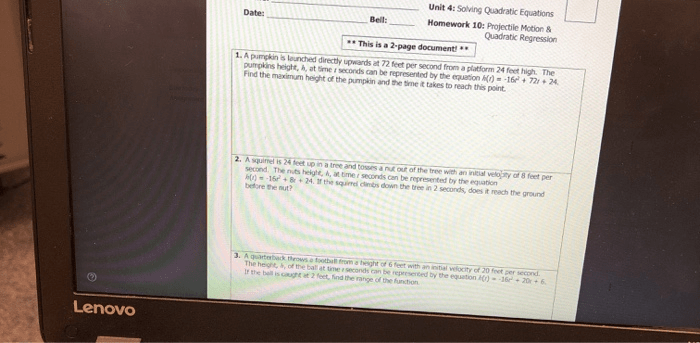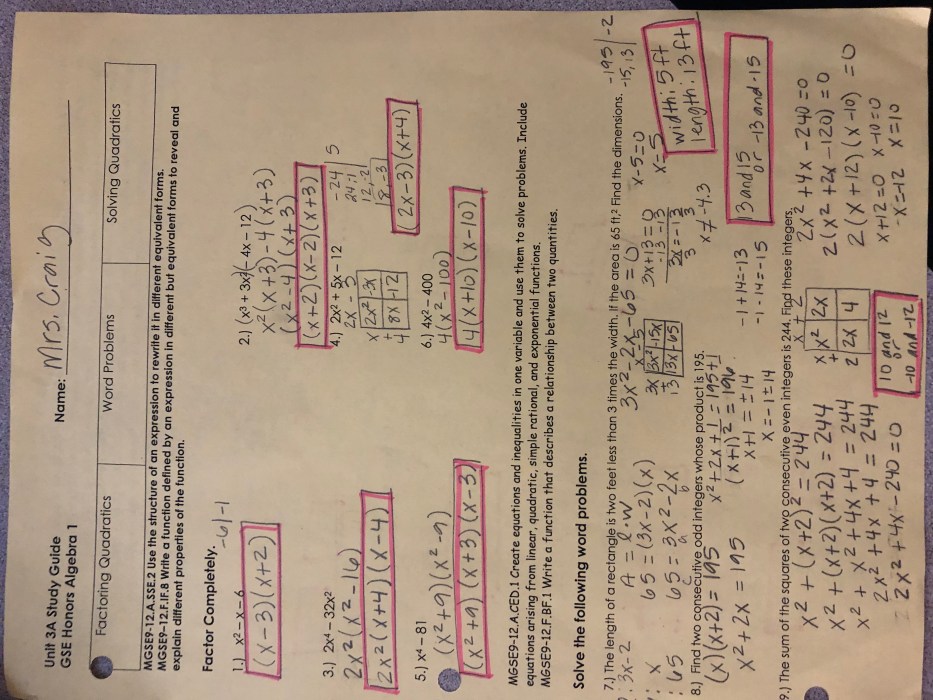As Unit 4 Solving Quadratic Equations Homework 2 takes center stage, this opening passage beckons readers into a world of mathematical exploration. Quadratic equations, with their intriguing standard form and diverse solution methods, offer a captivating challenge that demands a comprehensive understanding of factoring, completing the square, and the quadratic formula.
Prepare to embark on an engaging journey as we delve into the intricacies of these equations and their real-world applications.
This comprehensive guide will provide a step-by-step exploration of each method, empowering you to confidently tackle any quadratic equation that comes your way. Whether you’re encountering two distinct real roots, a single real root, or complex roots, we’ve got you covered.
Dive in and discover the elegance and power of quadratic equations!
Solving Quadratic Equations
Quadratic equations are equations of the form ax² + bx + c = 0, where a, b, and c are constants and a ≠ 0. They can be solved using various methods, including factoring, completing the square, and the quadratic formula.
Factoring Method
Factoring involves finding two factors of the quadratic expression ax² + bx + c that, when multiplied together, give the original expression. If the quadratic can be factored as (px + q)(rx + s), then the solutions to the equation are x = -q/p and x = -s/r.
Distinct Real Roots
If the quadratic can be factored into two distinct linear factors, then it has two distinct real roots.
One Real Root
If the quadratic can be factored as a perfect square, then it has one real root.
Complex Roots
If the quadratic cannot be factored over real numbers, then it has two complex roots.
Completing the Square Method: Unit 4 Solving Quadratic Equations Homework 2
Completing the square involves adding and subtracting a constant term to the quadratic expression so that it can be written as a perfect square trinomial. Once the expression is a perfect square, it can be solved using square roots.
Example, Unit 4 solving quadratic equations homework 2
To solve x² + 6x + 5 = 0 using completing the square, we add and subtract (6/2)² = 9 to the left-hand side:
- x² + 6x + 9 – 9 + 5 = 0
- (x + 3)² – 4 = 0
- (x + 3)² = 4
- x + 3 = ±2
- x = -3 ± 2
- x = -1 or x = -5
Quadratic Formula

The quadratic formula is a general formula that can be used to solve any quadratic equation. It is given by:
x = (-b ± √(b²
4ac)) / 2a
where a, b, and c are the coefficients of the quadratic equation.
Example, Unit 4 solving quadratic equations homework 2
To solve x² – 5x + 6 = 0 using the quadratic formula, we plug in the values a = 1, b = -5, and c = 6:
- x = (-(-5) ± √((-5)² – 4(1)(6))) / 2(1)
- x = (5 ± √(25 – 24)) / 2
- x = (5 ± 1) / 2
- x = 2 or x = 3
Applications of Quadratic Equations

Quadratic equations have numerous applications in real-world problems, including:
- Projectile motion
- Geometric problems
- Financial modeling
Example, Unit 4 solving quadratic equations homework 2
To find the height of a projectile at time t, we can use the quadratic equation h = -16t² + vt + h₀, where h₀ is the initial height, v is the initial velocity, and g is the acceleration due to gravity.
FAQ Explained
What is the standard form of a quadratic equation?
ax² + bx + c = 0, where a ≠ 0
When should I use factoring to solve a quadratic equation?
When the quadratic expression can be factored into two binomials.
How do I complete the square to solve a quadratic equation?
Add and subtract the square of half the coefficient of x to both sides of the equation.
